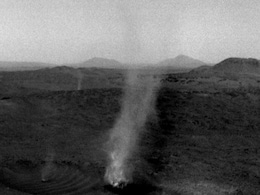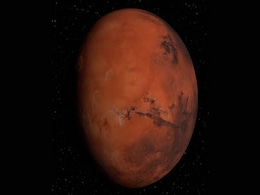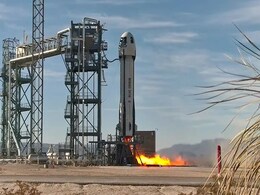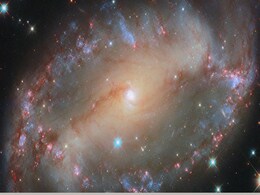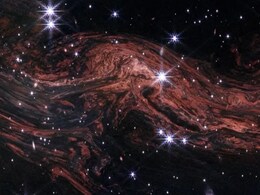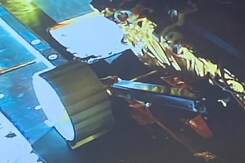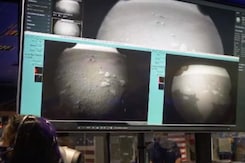Space Dust
- All
- News
- Videos
-

NASA's Perseverance Rover Captures One Dust Devil Devouring Another
- Monday April 7, 2025
- Written by Gadgets 360 Staff
NASA's Perseverance Mars rover's navigation camera captured a Martian dust devil swallowing a smaller one. The smaller dust devil's demise was captured during an imaging experiment carried out by Perseverance's science team to better understand the dynamics at work in the Martian atmosphere. In the 1970s, NASA's Viking orbiters became the first spa...
-
 www.gadgets360.com
www.gadgets360.com
-

Wolf-Rayet 104's Orbit Tilt Reduces Gamma-Ray Burst Threat, Study Finds
- Thursday March 20, 2025
- Written by Gadgets 360 Staff
New research using Keck Observatory’s instruments confirms that the orbit of Wolf-Rayet 104 is tilted 30-40 degrees away from Earth, lowering concerns about a possible gamma-ray burst. Previously, it was believed that the system’s alignment could pose a risk. However, spectroscopy data now challenges these assumptions, raising new questions abo...
-
 www.gadgets360.com
www.gadgets360.com
-

Best Vacuum Cleaners On Flipkart For A Sparkling Clean Home Under ₹10,000
- Monday March 10, 2025
- Shopping | Priya Raina
Finding the perfect vacuum cleaner for your home can be a daunting task, especially when you're on a budget. But don't worry, here, are some of the best vacuum cleaners on Flipkart that'll give you a sparkling clean home under ₹10,000.
-
 www.ndtv.com
www.ndtv.com
-

Solar System’s Journey Through Orion Complex May Have Altered Earth’s Climate
- Monday March 3, 2025
- Written by Gadgets 360 Staff
Scientists have studied the solar system’s passage through the Orion complex, a dense region in space, around 14 million years ago. According to researchers, this movement may have compressed the heliosphere and increased interstellar dust reaching Earth. This dust could have influenced the planet’s climate and left traces in geological records...
-
 www.gadgets360.com
www.gadgets360.com
-

New Research Reveals Mars’ Red Colour Linked to Ancient Water Presence
- Monday March 3, 2025
- Written by Gadgets 360 Staff
A recent study suggests that Mars’ red hue originates from ferrihydrite, an iron oxide that forms in water-rich environments. Scientists recreated Martian dust in labs and found that the mineral remained stable despite the planet’s dry conditions. Data from orbiting spacecraft and rovers confirm this discovery, reshaping theories about Mars’ ...
-
 www.gadgets360.com
www.gadgets360.com
-

Hubble Captures Stunning Tarantula Nebula Image, Revealing Cosmic Dust and Star Formation
- Thursday February 27, 2025
- Written by Gadgets 360 Staff
A new image from the Hubble Space Telescope highlights the Tarantula Nebula’s complex structure, featuring dense cosmic dust clouds and vibrant star-forming regions. This nebula, located 160,000 light-years away, plays a vital role in understanding stellar evolution. The captured details offer insights into how cosmic dust contributes to star and...
-
 www.gadgets360.com
www.gadgets360.com
-

Hubble’s New Image of Tarantula Nebula Showcases Cosmic Dust and Star Formation
- Tuesday February 18, 2025
- Written by Gadgets 360 Staff
NASA/ESA’s Hubble Space Telescope has captured a breathtaking image of the Tarantula Nebula, located 160,000 light-years away in the Large Magellanic Cloud. The image reveals intricate cosmic dust patterns and active star formation, offering valuable insights into the role of interstellar material in stellar evolution. Researchers are using the d...
-
 www.gadgets360.com
www.gadgets360.com
-

JWST Unveils HH 30’s Protoplanetary Disk, Showing Dust Grains and Jets
- Monday February 10, 2025
- Written by Gadgets 360 Staff
The James Webb Space Telescope has captured an extraordinary image of HH 30, a protoplanetary disk in the Taurus constellation. The dense dust disk conceals the central star, while bright jets extend outward, interacting with surrounding gas. Microscopic dust grains within the disk have been identified, playing a crucial role in planetary formation...
-
 www.gadgets360.com
www.gadgets360.com
-

Blue Origin’s New Shepard NS-29 Conducts First Lunar Gravity Simulation
- Thursday February 6, 2025
- Written by Gadgets 360 Staff
Blue Origin successfully launched its NS-29 mission, marking the first lunar gravity simulation on its New Shepard vehicle. The capsule rotated mid-flight to replicate Moon gravity for research payloads, including NASA-supported experiments on lunar dust behaviour and fire safety. Over half of the 30 payloads focused on Moon-related technologies. T...
-
 www.gadgets360.com
www.gadgets360.com
-

Hubble Spots Distant Supernova in Gemini, Enhancing Cosmic Distance Studies
- Tuesday February 4, 2025
- Written by Gadgets 360 Staff
The NASA/ESA Hubble Space Telescope has captured a stunning image of SN 2022aajn, a Type Ia supernova in the constellation Gemini. Located 600 million light-years away, the explosion was first detected in November 2022. Type Ia supernovae serve as essential cosmic distance markers due to their predictable brightness. Hubble’s observations, part o...
-
 www.gadgets360.com
www.gadgets360.com
-

Hubble Telescope Observes Young Stars HOPS 150 and HOPS 153 in Orion Nebula
- Wednesday January 22, 2025
- Written by Gadgets 360 Staff
The Hubble Space Telescope has captured images of two young stars, HOPS 150 and HOPS 153, in the Orion Nebula, which is located about 1,300 light-years from Earth. The binary system HOPS 150 glows in bright golden red, while HOPS 153 emits a colorful jet. These stars are still in their early stages of development, feeding from their surrounding dus...
-
 www.gadgets360.com
www.gadgets360.com
-

Hubble Telescope Captures Stunning View of Orion Nebula’s Protostars
- Monday January 20, 2025
- Written by Gadgets 360 Staff
The Hubble Space Telescope has captured a stunning view of the Orion Nebula, located 1,500 light-years from Earth. The new image highlights protostars HOPS 150 and HOPS 153, which are playing a key role in shaping their environment. These young stars are still in the process of formation, with the nebula's gas and dust feeding their growth. HOPS 15...
-
 www.gadgets360.com
www.gadgets360.com
-

NASA's TESS Discovers Fastest Disintegrating Planet Ever Seen: What You Need to Know
- Monday January 20, 2025
- Written by Gadgets 360 Staff
NASA’s TESS has observed the closest and fastest disintegrating planet, BD+05 4868 Ab, located 141 light-years away. The planet loses a moon’s mass every million years as it is bombarded by its host star. Scientists are examining its massive dust trails, offering rare insights into the composition of terrestrial exoplanets. Researchers from MIT...
-
 www.gadgets360.com
www.gadgets360.com
-

James Webb Space Telescope Unveils Hidden Interstellar Wonders of Supernova Cassiopeia A
- Friday January 17, 2025
- Written by Gadgets 360 Staff
The James Webb Space Telescope has provided a rare glimpse into the remnants of a centuries-old supernova in Cassiopeia A. Using infrared technology, the telescope captured a light echo caused by a massive star’s explosion, unveiling new insights into the interstellar medium and its magnetic structures. This breakthrough discovery offers valuable...
-
 www.gadgets360.com
www.gadgets360.com
-

NASA's James Webb Space Telescope Shows 3D Structure Of Dust And Gas Between Stars
- Thursday January 16, 2025
- Science | Edited by NDTV News Desk
NASA's James Webb Space Telescope has captured highly detailed images showing the complex layers of interstellar dust and gas.
-
 www.ndtv.com
www.ndtv.com
-

NASA's Perseverance Rover Captures One Dust Devil Devouring Another
- Monday April 7, 2025
- Written by Gadgets 360 Staff
NASA's Perseverance Mars rover's navigation camera captured a Martian dust devil swallowing a smaller one. The smaller dust devil's demise was captured during an imaging experiment carried out by Perseverance's science team to better understand the dynamics at work in the Martian atmosphere. In the 1970s, NASA's Viking orbiters became the first spa...
-
 www.gadgets360.com
www.gadgets360.com
-

Wolf-Rayet 104's Orbit Tilt Reduces Gamma-Ray Burst Threat, Study Finds
- Thursday March 20, 2025
- Written by Gadgets 360 Staff
New research using Keck Observatory’s instruments confirms that the orbit of Wolf-Rayet 104 is tilted 30-40 degrees away from Earth, lowering concerns about a possible gamma-ray burst. Previously, it was believed that the system’s alignment could pose a risk. However, spectroscopy data now challenges these assumptions, raising new questions abo...
-
 www.gadgets360.com
www.gadgets360.com
-

Best Vacuum Cleaners On Flipkart For A Sparkling Clean Home Under ₹10,000
- Monday March 10, 2025
- Shopping | Priya Raina
Finding the perfect vacuum cleaner for your home can be a daunting task, especially when you're on a budget. But don't worry, here, are some of the best vacuum cleaners on Flipkart that'll give you a sparkling clean home under ₹10,000.
-
 www.ndtv.com
www.ndtv.com
-

Solar System’s Journey Through Orion Complex May Have Altered Earth’s Climate
- Monday March 3, 2025
- Written by Gadgets 360 Staff
Scientists have studied the solar system’s passage through the Orion complex, a dense region in space, around 14 million years ago. According to researchers, this movement may have compressed the heliosphere and increased interstellar dust reaching Earth. This dust could have influenced the planet’s climate and left traces in geological records...
-
 www.gadgets360.com
www.gadgets360.com
-

New Research Reveals Mars’ Red Colour Linked to Ancient Water Presence
- Monday March 3, 2025
- Written by Gadgets 360 Staff
A recent study suggests that Mars’ red hue originates from ferrihydrite, an iron oxide that forms in water-rich environments. Scientists recreated Martian dust in labs and found that the mineral remained stable despite the planet’s dry conditions. Data from orbiting spacecraft and rovers confirm this discovery, reshaping theories about Mars’ ...
-
 www.gadgets360.com
www.gadgets360.com
-

Hubble Captures Stunning Tarantula Nebula Image, Revealing Cosmic Dust and Star Formation
- Thursday February 27, 2025
- Written by Gadgets 360 Staff
A new image from the Hubble Space Telescope highlights the Tarantula Nebula’s complex structure, featuring dense cosmic dust clouds and vibrant star-forming regions. This nebula, located 160,000 light-years away, plays a vital role in understanding stellar evolution. The captured details offer insights into how cosmic dust contributes to star and...
-
 www.gadgets360.com
www.gadgets360.com
-

Hubble’s New Image of Tarantula Nebula Showcases Cosmic Dust and Star Formation
- Tuesday February 18, 2025
- Written by Gadgets 360 Staff
NASA/ESA’s Hubble Space Telescope has captured a breathtaking image of the Tarantula Nebula, located 160,000 light-years away in the Large Magellanic Cloud. The image reveals intricate cosmic dust patterns and active star formation, offering valuable insights into the role of interstellar material in stellar evolution. Researchers are using the d...
-
 www.gadgets360.com
www.gadgets360.com
-

JWST Unveils HH 30’s Protoplanetary Disk, Showing Dust Grains and Jets
- Monday February 10, 2025
- Written by Gadgets 360 Staff
The James Webb Space Telescope has captured an extraordinary image of HH 30, a protoplanetary disk in the Taurus constellation. The dense dust disk conceals the central star, while bright jets extend outward, interacting with surrounding gas. Microscopic dust grains within the disk have been identified, playing a crucial role in planetary formation...
-
 www.gadgets360.com
www.gadgets360.com
-

Blue Origin’s New Shepard NS-29 Conducts First Lunar Gravity Simulation
- Thursday February 6, 2025
- Written by Gadgets 360 Staff
Blue Origin successfully launched its NS-29 mission, marking the first lunar gravity simulation on its New Shepard vehicle. The capsule rotated mid-flight to replicate Moon gravity for research payloads, including NASA-supported experiments on lunar dust behaviour and fire safety. Over half of the 30 payloads focused on Moon-related technologies. T...
-
 www.gadgets360.com
www.gadgets360.com
-

Hubble Spots Distant Supernova in Gemini, Enhancing Cosmic Distance Studies
- Tuesday February 4, 2025
- Written by Gadgets 360 Staff
The NASA/ESA Hubble Space Telescope has captured a stunning image of SN 2022aajn, a Type Ia supernova in the constellation Gemini. Located 600 million light-years away, the explosion was first detected in November 2022. Type Ia supernovae serve as essential cosmic distance markers due to their predictable brightness. Hubble’s observations, part o...
-
 www.gadgets360.com
www.gadgets360.com
-

Hubble Telescope Observes Young Stars HOPS 150 and HOPS 153 in Orion Nebula
- Wednesday January 22, 2025
- Written by Gadgets 360 Staff
The Hubble Space Telescope has captured images of two young stars, HOPS 150 and HOPS 153, in the Orion Nebula, which is located about 1,300 light-years from Earth. The binary system HOPS 150 glows in bright golden red, while HOPS 153 emits a colorful jet. These stars are still in their early stages of development, feeding from their surrounding dus...
-
 www.gadgets360.com
www.gadgets360.com
-

Hubble Telescope Captures Stunning View of Orion Nebula’s Protostars
- Monday January 20, 2025
- Written by Gadgets 360 Staff
The Hubble Space Telescope has captured a stunning view of the Orion Nebula, located 1,500 light-years from Earth. The new image highlights protostars HOPS 150 and HOPS 153, which are playing a key role in shaping their environment. These young stars are still in the process of formation, with the nebula's gas and dust feeding their growth. HOPS 15...
-
 www.gadgets360.com
www.gadgets360.com
-

NASA's TESS Discovers Fastest Disintegrating Planet Ever Seen: What You Need to Know
- Monday January 20, 2025
- Written by Gadgets 360 Staff
NASA’s TESS has observed the closest and fastest disintegrating planet, BD+05 4868 Ab, located 141 light-years away. The planet loses a moon’s mass every million years as it is bombarded by its host star. Scientists are examining its massive dust trails, offering rare insights into the composition of terrestrial exoplanets. Researchers from MIT...
-
 www.gadgets360.com
www.gadgets360.com
-

James Webb Space Telescope Unveils Hidden Interstellar Wonders of Supernova Cassiopeia A
- Friday January 17, 2025
- Written by Gadgets 360 Staff
The James Webb Space Telescope has provided a rare glimpse into the remnants of a centuries-old supernova in Cassiopeia A. Using infrared technology, the telescope captured a light echo caused by a massive star’s explosion, unveiling new insights into the interstellar medium and its magnetic structures. This breakthrough discovery offers valuable...
-
 www.gadgets360.com
www.gadgets360.com
-

NASA's James Webb Space Telescope Shows 3D Structure Of Dust And Gas Between Stars
- Thursday January 16, 2025
- Science | Edited by NDTV News Desk
NASA's James Webb Space Telescope has captured highly detailed images showing the complex layers of interstellar dust and gas.
-
 www.ndtv.com
www.ndtv.com

